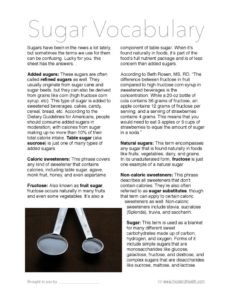Sugar Vocabulary Guide
Sugars have been in the news a lot lately, but sometimes the terms we use for them can be confusing. Lucky for you, this post has the answers…Added sugars: These sugars are often called refined sugars as well. They usually originate from sugar cane and sugar beets, but they can also be derived from grains like corn (high fructose corn syrup, etc). This type of sugar is added to sweetened beverages, cakes, candy, cereal, bread, etc. According to the Dietary Guidelines for Americans, people should consume added sugars in moderation, with calories from sugar making up no more than 10% of their total calorie intake. Table sugar (aka sucrose) is just one of many types of added sugars.Caloric sweeteners: This phrase covers any kind of sweetener that contains calories, including table sugar, agave, monk fruit, honey, and even aspartame.Fructose: Also known as fruit sugar, fructose occurs naturally in many fruits and even some vegetables. It’s also a component of table sugar. When it’s found naturally in foods, it’s part of the food’s full nutrient package and is of less concern than added sugars.According to Beth Rosen, MS, RD, “The difference between fructose in fruit compared to high-fructose corn syrup in sweetened beverages is the concentration. While a 20-oz bottle of cola contains 36 grams of fructose, an apple contains 12 grams of fructose per serving, and a serving of strawberries contains 4 grams. This means that you would need to eat 3 apples or 9 cups of strawberries to equal the amount of sugar in a soda.”Natural sugars: This term encompasses any sugar that is found naturally in foods like fruits, vegetables, dairy, and grains. These sugars are part of a foods full nutrient package. In its unadulterated form, fructose is just one example of a natural sugar.Non-caloric sweeteners: This phrase describes all sweeteners that don’t contain calories. Non-caloric sweeteners include stevia, sucralose (Splenda), truvia, and saccharin.Sugar: This term is used as a blanket for many different sweet carbohydrates made up of carbon, hydrogen, and oxygen. Forms of it include simple sugars that are monosaccharides like glucose, galactose, fructose, and dextrose, and complex sugars that are disaccharides like sucrose, maltose, and lactose.Sugar substitutes: This term applies to caloric and non-caloric sweeteners that are not actually sugar. Honey, agave, stevia, aspartame, and monk fruit are all sugar substitutes.Want to share this great information with your clients? Print or download this handout with the highlights from today's post... And here are a few more sugar resources, designed to make your life easier...
And here are a few more sugar resources, designed to make your life easier...
